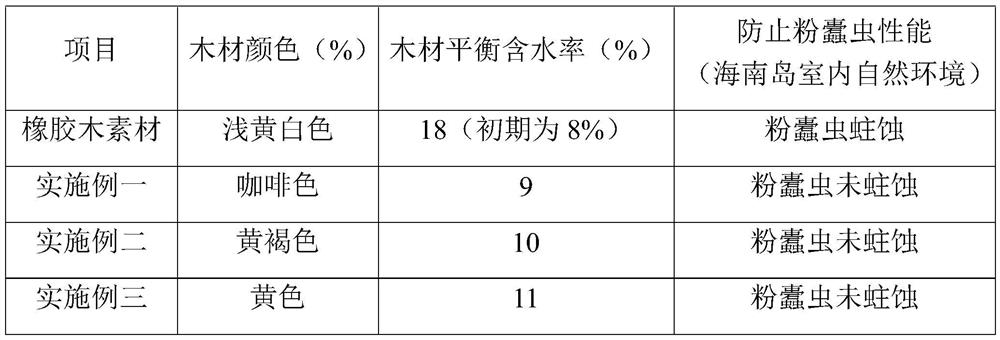Method for processing root carving and timber pier by using rubber tree log and root material
A processing method and rubber tree technology, applied in wood processing appliances, wood treatment, wood heat treatment and other directions, can solve the problems of insufficient color, texture, density and dimensional stability, low added value, decay and other problems, and achieve elegant color and pattern. Equilibrium moisture content stability, wood dimensional stability effect
- Summary
- Abstract
- Description
- Claims
- Application Information
AI Technical Summary
Problems solved by technology
Method used
Image
Examples
Embodiment 1
[0029] 1), rubber tree root cleaning, removal of mud, root diameter 40-80cm, length 50-100cm, initial moisture content 70-80%, quantity 20;
[0030] 2) Put the tree roots on the timber cart, stack them and fix them properly with steel ropes, keep them stable, and wait for drying and high temperature treatment;
[0031] 3) Put the stacked tree roots into the wood high-temperature drying treatment kiln, heat, and pass in steam to raise the temperature to 90°C, continue heating during the day, shut down the kiln at night, cool down naturally to 50°C, close the intake and exhaust ports or Slightly open, repeat operation for 7 days, increase the kiln temperature and feed steam, heat up to 120°C, continue heating during the day, shut down the kiln at night, naturally cool down to 85°C, close the intake and exhaust ports, and process for 48 hours, then raise the kiln again Temperature to 155°C, treatment time 24 hours, air intake and exhaust ports closed, temperature lowered to 85°C,...
Embodiment 2
[0034] 1), rubber tree logs are cleaned to remove mud, the log diameter is 50-70cm, the length is 200-230cm, the quantity is 5 sections, and the initial moisture content is 60-70%;
[0035] 2), put the logs on the timber cart, stack them and separate them with spacers, and wait for drying and high temperature treatment;
[0036] 3) Put the stacked logs into the wood high-temperature drying kiln, heat them, and pass in steam to raise the temperature to 80°C, continue heating during the day, shut down the kiln at night, cool down naturally to 55°C, close the intake and exhaust ports or slightly Turn on, repeat the operation for 7 days, increase the kiln temperature and feed steam, heat up to 115°C, continue heating during the day, shut down the kiln at night, naturally cool down to 80°C, close the intake and exhaust ports, and process for 72 hours, then increase the kiln temperature again To 150°C, the processing time is 24 hours, the intake and exhaust ports are closed, the tem...
Embodiment 3
[0039] 1) Clean the rubber wood log and remove the mud. The diameter of the log is 10-20cm, the length is 200-300cm, the quantity is 100 sections, and the initial moisture content is 50-60%;
[0040] 2), put the logs on the timber cart, stack them and separate them with spacers, and wait for drying and high temperature treatment;
[0041] 3) Put the stacked logs into a wood high-temperature drying kiln, heat them, and pass in steam to raise the temperature to 87°C, continue heating during the day, shut down the kiln at night, cool down naturally to 57°C, close the intake and exhaust ports or slightly Turn on, repeat the operation for 3 days, increase the temperature of the kiln and feed steam, raise the temperature to 125°C, continue heating during the day, shut down the kiln at night, and naturally cool down to 90°C, close the intake and exhaust ports, process for 24 hours, and increase the kiln temperature again To 157°C, the processing time is 12 hours, the intake and exhau...
PUM
 Login to View More
Login to View More Abstract
Description
Claims
Application Information
 Login to View More
Login to View More - R&D
- Intellectual Property
- Life Sciences
- Materials
- Tech Scout
- Unparalleled Data Quality
- Higher Quality Content
- 60% Fewer Hallucinations
Browse by: Latest US Patents, China's latest patents, Technical Efficacy Thesaurus, Application Domain, Technology Topic, Popular Technical Reports.
© 2025 PatSnap. All rights reserved.Legal|Privacy policy|Modern Slavery Act Transparency Statement|Sitemap|About US| Contact US: help@patsnap.com

